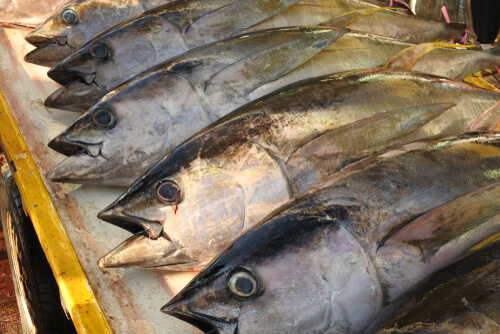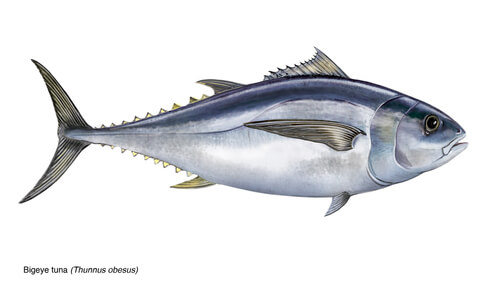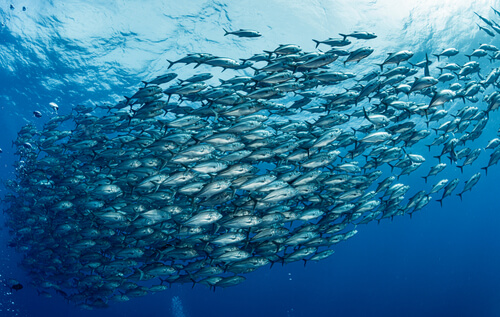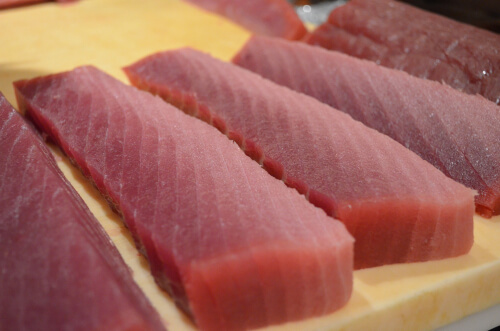
| Kingdom | Animalia |
| Phylum | Chordata |
| Class | Actinopterygii |
| Order | Scombriformes |
| Family | Scombridae |
| Genus | Thunnus |
| Species | T. obesus |
| Niche | Epipelagic predator |
| Length | 98 in (2.5 m) |
| Weight | 400 lb (180 kg) |
| Lifespan | 9 years |
| Social Structure | Schooling predator |
| Conservation Status | Vulnerable |
| Preferred Habitat | Indian, Atlantic, Pacific Oceans, primarily offshore |
| Average Clutch Size | Millions of eggs |
| Main Food Items and Prey | Fish, crustaceans, squids, etc. |
| Predators | False killer whale, mako shark, great white shark |
The Basics
The bigeye tuna (Thunnus obesus) is a species of tuna belonging to the family Scombridae. They are found in tropical and temperate oceans around the world and form an important commercial fishery in many regions.
Description
Like other tuna, the bigeye tuna is rhomboidal, or football-shaped. They have large mouths at the end of their conical heads, with large eyes on each side. Like albacore tuna, they have long pectoral fins. They also have two dorsal fins and two anal fins, along with a series of about 5-8 finlets along each of their dorsal and ventral sides between their tail fin and their anterior anal and dorsal fins, all of which are often colored yellow or orange in mature individuals.

The bigeye tuna is charcoal on its dorsal or upper side, turning to a silvery-white color on its flanks and ventral or underside. They are large fish, growing up to 8 feet in length and up to 400 pounds, making them moderate in terms of size among all tunas with the Atlantic bluefin tuna being the largest.
Habitat and Distribution
Bigeye tuna are present in all of the world’s oceans within tropical and temperate waters. However, they are not present in the Mediterranean Sea.

Like other tuna species, bigeye tuna are epipelagic. They spend much of their time in surface waters, particularly at night when prey is likely more abundant. During the day, they frequently dive to depths of up to 1,500 feet below the surface. They often school with other members of their own species or other similar fish of a similar size, such as other tuna.
Diet and Predators
The likely reason for this deep-diving behavior of several species of tuna is the pursuit of prey. Bigeye tuna are fast, strong, swimmers that will use their speed to ambush various prey species such as fish and crustaceans. They are also known to hunt various species of cephalopods such as octopus, cuttlefish, and squid.
Adult bigeye are capable of avoiding predation by all but the largest of predators such as the false killer whale and likely orca on occasion. They are also susceptible to prey be sharks such as the mako shark and the great white shark. Juvenile tuna may also add to this list other large predatory fish species, including larger tuna.
Reproduction
Bigeye tuna spawn throughout the year, particularly in the tropics. This behavior becomes more seasonal at higher latitudes, perhaps due to a more distinct variation in seasonal productivity in these regions.
Bigeye tuna are broadcast spawners, meaning females will release their eggs into the water column to be fertilized by the sperm of males that do the same. Once this external fertilization occurs, the embryo will develop into a larval fish as part of the zooplankton community. Soon after, it will develop into a small juvenile tuna and begin hunting smaller organisms.
Bigeye tuna are known to live to about 16 years, likely reaching sexual maturity between the ages of two and four years.
Conservation Status
The bigeye tuna is a popular target of commercial fisheries, with up to 500,000 tonnes landed globally each year. Due to their migratory nature, management of these stocks is difficult as it requires the agreement and cooperation of many jurisdictions. This intense fishery puts pressure on the population with many other effects at lower trophic levels due to the removal of one of the ecosystem’s apex predators.
In addition to overfishing, ocean warming due to global climate change is also a threat to the species. The effects of such changes are complex and dynamic. For example, one result is a reduction or shift in the marine phytoplankton community, which makes up the base of the food chain on which all other larger organisms rely. With primary production reduced, tuna and other species may experience this additional pressure which, in combination with overfishing, may be problematic for the future of the species. Currently, the bigeye tuna is listed as Vulnerable on the IUCN Red List of Threatened Species.
Fun Facts about the Bigeye Tuna!
Tuna are a fascinating and important group of fish. Not only are they important predators in the ecosystems they inhabit, but they are also economically important to fisheries around the world. Although the bigeye tuna is among the lesser-known species of tuna, it is no less important and interesting, with many fun facts and insights to explore through the lens of this species.
Uniquely Competent
Bigeye tuna, like other tuna species, are well adapted to their environments and have unique physiological traits that allow them to thrive in each of their particular niches. The bigeye tuna is particularly well adapted to low-oxygen environments, being known to tolerate levels as low as 1.0 ml/L. This occurs by having blood that binds particularly easily to oxygen due to the presence of a high concentration of hemoglobin.
Because many deep, cold-water environments tend to be oxygen-poor, this particular adaptation allows the bigeye tuna to access foraging areas that it wouldn’t otherwise be able to without its particularly hemoglobin-rich blood.
Vertically Gifted
The bigeye tuna makes good use of its physiological adaptations. Among tuna species, they exhibit perhaps the most distinct diurnal migration behavior pattern, traveling into deep waters during the day and surface waters by nightfall. They will regularly travel to depths of up to 1,500 feet during the day, experiencing a difference in temperature of up to 20°C in comparison to surface waters.

The depth to which populations normally dive changes throughout the world, pointing to the fact that they may be aiming for an optimal temperature range rather than depth. In warmer tropical regions, they may need to dive deeper to reach these temperatures whereas, in cooler temperate and subtropical waters, these temperatures will occur closer to the surface. It may not be particularly advantageous for the tuna to subsist in colder waters, but they may also complete this migration in response to their prey, which often includes various species of copepods such as squid which are well known for their own diurnal migration.
Same Same but Different
Being closely related, all tuna species have some common traits. This can often make them difficult to distinguish between. Perhaps the clearest example of this is the case of the bigeye tuna and the yellowfin tuna. Both grow to a similar size: larger than albacore tuna and smaller than the bluefin tuna. Both species even have large eyes and yellow fins. In fact, in Hawaii, both species are known as “Ahi”, the traditional name for tuna.
However, upon closer inspection, there are some important differences between the two species. Bigeye tuna are more rotund, possessing a particularly ‘plump’ body. Its eyes and head are also particularly large when closely compared to the yellowfin and other species of tuna. Although the yellowfin tuna is generally more well-known globally, the flesh of the bigeye tuna – with its slightly higher fat content – is preferred for sashimi.
This example highlights how speciation is not always clear. As organisms continue to adapt and evolve to a changing and dynamic environment, this is especially true. With similar traits and overlapping environments, hybridization may be possible in some cases, while in others members of the same species may become geographically isolated, eventually giving rise to two distinct species with similar characteristics and a recently shared lineage.
